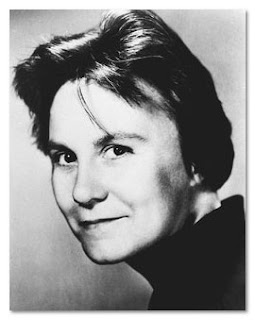1. What is the reason for the author's choice of a young narrator?
"To kill a Mockingbird" represents some very hard years for the US people. To express this tense situation in a kind and friendly way, Harper Lee uses a young girl, so the reader can understand the circumstances from an innocent but true point of view.
At the beginning, Scout and Jem see Boo Radley as a strange ghost. They fear the Radley's house and are afraid of its mysteries. However, as the time passes, Scout and Jem's view changes positively and they want to get nearer Boo. Moreover, in chapter 5, the guys write a letter and show it to him by the window to invite Boo to play with them. At the end of Part 1, the seem to lose some interest in this boy, because they are occupied in the fire of Ms. Maudie's house and then, in Ms. Dubose reading. However, in the first half of the book they never get a convincing explanation for the weird situation of the Radleys.
3. Atticus tells the children several times that they need to walk in someone else's shoes before judging the person. Describe times when Atticus, Scout or Jem walk in someone else's shoes. How does this change how they view the situations? What role does this advice play in sympathy and compassion?
When Scout realizes that Walter Cunningham didn't have lunch, after some problems with the teacher Jem invited him to have lunch in their house. There, Scout protested because Walter was pouring to much Syrup in his lunch, which caused Atticus and Calpurnia to punish him by sending Scout to the kitchen. Also, when Atticus gets to know that Jem cut Ms. Dubose's flowers, the old man made him go and read her book every day for more than a month. This was to teach Jem that he had to judge people according to their problems and circumstances.
4. How do you think Atticus managed his role as a single parent?
In my opinion, Atticus is a great father. He is the old wise man of the story, and he tries to teach his children with everyday problems. Also, he is supported by Calpurnia, who in some way replaces de missing mother.
5. Discuss race issues in part 1 of the book.
To Kill a Mockingbird represents many problems of the US society in the last century. One of them is Racism. Most of the persons who lived in Maycomb discriminate negroes and all the people who helped them. In Part 1, Cecil Jacobs and Ms. Dubose show an strong opposition to the black people. However, Atticus Finch brakes this belief and helps Tim Robinson, a black man. This situation causes a lot of problems for Scout, problems that she hardly understand.
6. From your reading of part 1, What does To Kill a Mockingbird teach us about how people cope with issues of race and class? Do you classify people in your world as different "folks?" Do you see those sort of distinctions today?
Harper Lee's book expresses the cruel reality. I think racism nowdays is much softer, but there are still some problems because persons differences. In my opinion, this happens mainly because we love to classify things. We don't see people as they are, but as components of groups or divisions of society, with peculiar characteristics. Therefore, we naturally tend to defend the groups we involuntarily belong to and discriminate others.
7. Who is your favorite character from part 1 and why?
Without doubts, Atticus Finch. He represents the thoughts of a developed man, someone who is looking towards changes and the future. He breakes old beliefs and behaviours and view things in a different way. He is not afraid to go against society if he thinks he is doing something right, and he is dedicated to educate his children.

